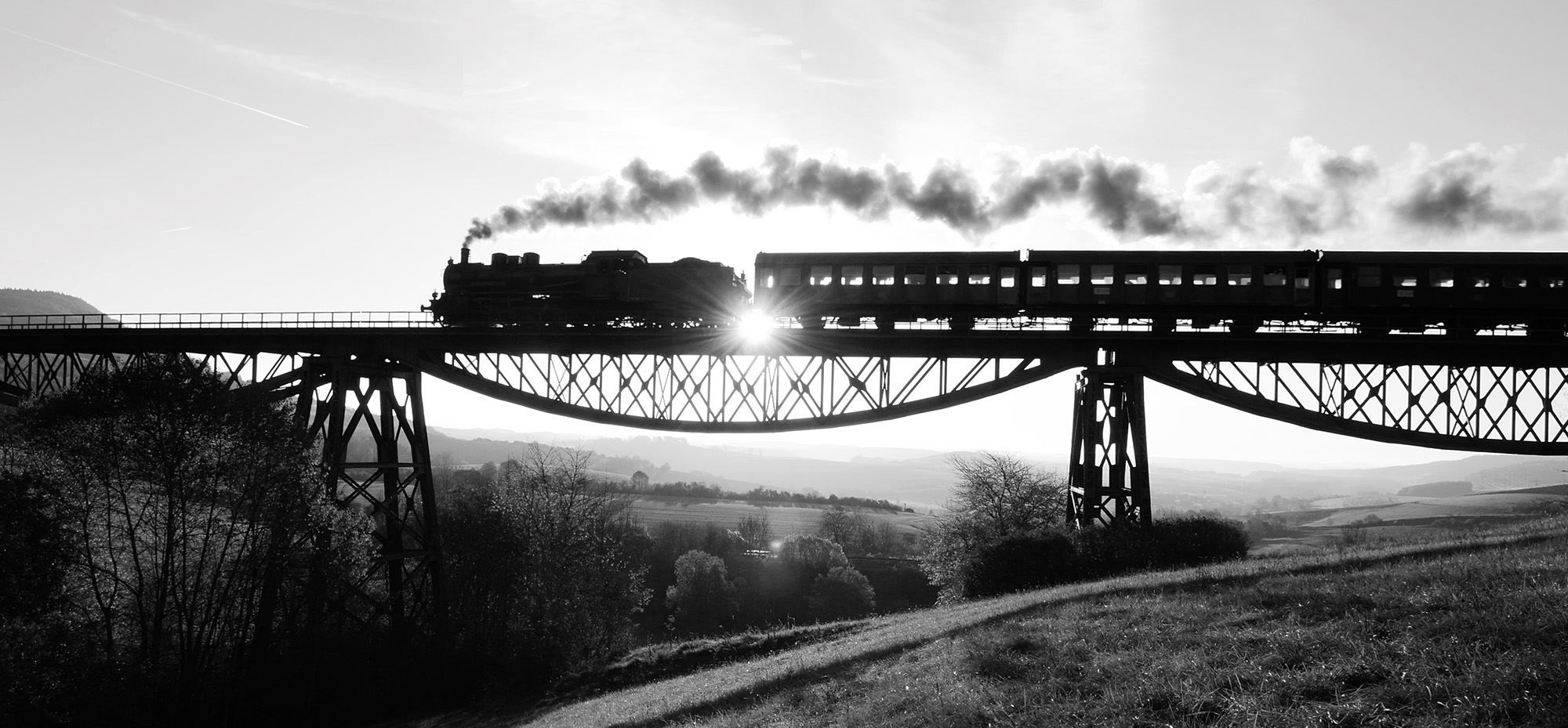
The History of Air Pollution
The history of anthropogenic air pollution goes further back than you may think. Most of us think it’s just another symptom of modern life. We often picture air pollution as the smog of Beijing, when the country issued a red alert closing schools and restricting traffic. The truth is, however, human activity induced polluted air has a much older narrative and it has been damaging urban and natural environments for centuries.
“By looking backwards to look forward, we allow ourselves to learn and make informed plans for future action.”
Sources prove that this centuries old atrocity has been known to us from long before this article was published. Evidence is categorised in four different groups: written documents, ground-based monitoring networks, chemistry transport models and satellite remote sensing.
To understand it all we need to travel back in time, starting from the miasma theory, voyaging through the industrial revolution and changing philosophies and scientific developments, to the climate change of today.
The origin of the Miasma theory
The miasma theory goes back as far as Hippocrates (c 460 – 377 BC). It states that diseases were caused by the presence of miasma (bad air), and that miasmas were poisonous emanations from putrefying organic matter as well as dust particles inside dwellings. It could be identified by its smell, and it was the prevailing philosophy of disease transmission from the time of ancient Greece up to the mid-19th century, when it was replaced by the Germ theory of diseases. Hippocrates’ publications (ca 400 BC) were the first testaments reporting concerns with corrupted air, suggesting illness to be related to the quality of the air.
Later, in Imperial Rome, writers, including Frontinus, recorded the possible health impacts of smoke. Even the residents of Rome referred to the city’s smoke cloud as gravioris caeli (heavy heaven) or infamis aer (infamous air). Further complaints about the effects of this fouled air were also documented by Seneca in A.D. 61.
Birthrights, Sea-Coal and Energy Revolution
In the year 535 the Byzantine Emperor Justinian (482 – 565) proclaimed the importance of clean air as a birthright amongst the Roman Laws, his ruling being a very early version of the UK Clean Air Act of today.
A book written by the Chinese Shen Kuo, during the Song Dynasty (AD 961 – 1279) produced some of the first concerns of air pollution from coal-burning. Following that, writers from the Arab world provided an additional source of proof about air pollution observations during the ‘Dark Ages’.
By 1200, London had been deforested and the transport of ‘sea-coal’ from Scotland and the north-east of England to London had begun, despite already having a reputation of being a dirty fuel since being recorded by the monks at Peterborough Abbey, AD 852. It was not suitable for use in domestic hearths, so was mainly utilised by artisans for lime burning, metal working and smelting. Sea-coal got its name from the places in Scotland and the north-east of England where the carboniferous strata were exposed on the seashore.
During the 13th century, as the use of coal amongst artisans became more widespread the adverse effects of coal burning were quite clear, leaving London’s population with unrest and agitation. Royalty frequently fled London for the rural countryside due to the unendurable smoke. Another recorded anxiety with coal smoke was when Eleanor, wife of Henry III, was forced to flee Nottingham Castle in 1257 due to the fumes from coal-burning.
As a result, the English Parliament passed a law in 1273, the Smoke Abatement Act, prohibiting the burning of soft coal. It restrained the use of coal as it was labelled ‘prejudicial to health’ however, the regulations only required that sources were kept outside the city walls, a mediaeval approach that followed the ancient Roman regulation concept. This inadequate practice continued throughout the Middle Ages in Europe and Asia. Despite the law, the situation did not improve, in fact, it got so appalling by 1306 that Edward I appointed a commission to enforce the anti-smoke law in London, which like other attempts to regulate coal burning, had very little effect. These regulations are early examples of what we now call ‘environmental law’.
With the improvement of domestic hearths, coal began to be used in households of coal producing areas during the first half of the 14th century. There was a steady increase in demand for coal in Britain during the 15th century, but it was still mainly amongst coal mining districts or coastal towns. As supplies of wood had been depleted by the mid-16th century in Britain, coal use for domestic fuel rapidly amplified. Coal soon became the main fuel that powered London, and the national and international trade of coal began.
Observations, nuisances, and inconveniences
Europeans imported air pollution to the New World when Spanish conquistadors mined silver in 1572, with a technique called amalgamation that grinds ore into powder and which shoots lead plumes into the air during the process.
Back in Britain, by the 1600s coal burning smoke had also started to damage London’s and other major cities’ architecture (See 10 Downing Street renovations in the 1950s). And from the mid – 1600s in British cities, especially in London, incidences of ill-health were a result of coal smoke from chimneys mixed with mists and fogs from the Thames Valley.
Meanwhile, James I required parish clerks to publish weekly lists of the so-called Bills of Mortality. A Bill first produced in 1532 to record weekly mortality statistics of the City of London during outbreaks of plague, were now being published continuously on his orders.
A dispute over a pigsty in 1610 led to ‘The Law of Nuisance’. The quarrel started when Thomas Benton built a pigsty on his property so ‘near to the house of the plaintiff that the air thereof was corrupted’. The plaintiff, William Aldred’s case, laid the foundations of Environmental Law in the UK. This saga also proved that the common law was inadequate to address issues with increasing urbanisation which gave rise to self-evident public health and welfare affairs. Even the legendary jurist Edward Coke had argued in the late 1500s that ‘lights and sweet air were as necessary as pure and wholesome water’.
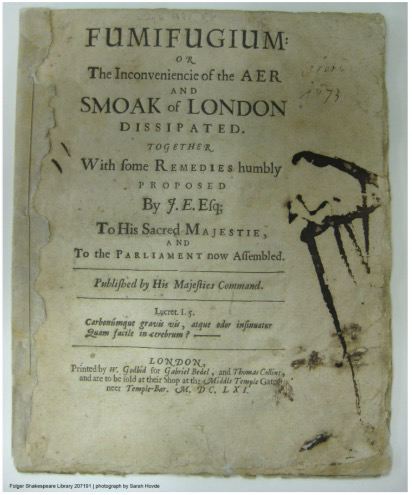 The diarist and gardener, John Evelyn used the Bill of Mortality as evidence in his essay, Fumifugium: or The Inconvenience of the Aer and Smoak of London Dissipated (1661) which he sent to King Charles II and his parliament. It was the constant deaths from chronic diseases that piqued his interest ‘…almost half of the people who die in London do so from disorders of the throat or lungs. The inhabitants are never free from coughs or persistent rheumatism…’. Despite this evidence, the consensus was that smoke was good for the people. Even the College of Physicians considered it a preservation against infection, rather than the cause of the effects that he had described. This belief had rooted in the miasma theory discussed earlier; and this isn’t the only example where smoke had been portrayed as a positive circumstance.
The diarist and gardener, John Evelyn used the Bill of Mortality as evidence in his essay, Fumifugium: or The Inconvenience of the Aer and Smoak of London Dissipated (1661) which he sent to King Charles II and his parliament. It was the constant deaths from chronic diseases that piqued his interest ‘…almost half of the people who die in London do so from disorders of the throat or lungs. The inhabitants are never free from coughs or persistent rheumatism…’. Despite this evidence, the consensus was that smoke was good for the people. Even the College of Physicians considered it a preservation against infection, rather than the cause of the effects that he had described. This belief had rooted in the miasma theory discussed earlier; and this isn’t the only example where smoke had been portrayed as a positive circumstance.
Industrial Revolution, the accelerator of environmental issues
When English inventor, Thomas Newcomen created the first practical Steam Engine in 1712 it was intended to be used to pump water from coal mines, to increase access and the amount of coal being mined. This invention indirectly boosted the demand for coal through industrialisation.
The Scottish engineer, James Watt, further developed the Steam Engine in 1776, making it more energy efficient. Eventually he adapted his engine to produce rotary motion, greatly broadening its use from pumping water. This energy efficient engine granted space for centralised factories to emerge. Soon enough the small water-powered mills were outgrown by factories with their own steam engine and a chimney which gave efficient draft to the instrument through the boilers. In this age of industrialisation, the number of houses with chimneys rapidly grew and the services of chimney sweeps became much sought-after. In 1775, the English surgeon Percivall Pott was the first to demonstrate the carcinogen effects from exposure to soot in chimney sweeps. His investigations later led to the Chimney Sweepers Act of 1788.
“The Industrial Revolution had begun, originating in Britain, it spread across the world in three waves between 1760 and 1840.”
The Industrial Revolution had begun, originating in Britain, it spread across the world in three waves between 1760 and 1840. In 1807, inspired by the work of Watt and his creation, the American engineer, Robert Fulton built the first commercial steamboat to run on the Hudson River. Only seven years later, the English engineer, George Stephenson, renowned as the ‘Father of Railways’, pioneered rail transport when he built the first steam engine locomotive on rails in 1814. The first railroad opened to the public in 1830 between Liverpool and Manchester.
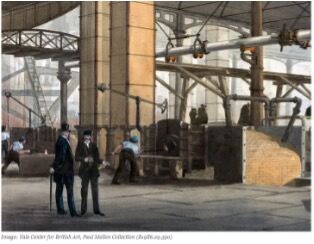 Interestingly, coal-steam powered engines weren’t the only ingenious inventions of the time. In 1816, the Scottish engineer, Robert Stirling patented the first air engine, the Stirling engine. This work of genius, the Heat Economiser, was also the predecessor of the regenerator. Robert and his brother patented this hot air engine, which had the hot ends of the displacers underneath the machinery. They also added compressed air pump so the air within could increase pressure. Even though, his engine was designed to fail far less catastrophically than the steam engines of the time while obtaining greater efficiency, it remained overshadowed by the more prevalent steam engines.
Interestingly, coal-steam powered engines weren’t the only ingenious inventions of the time. In 1816, the Scottish engineer, Robert Stirling patented the first air engine, the Stirling engine. This work of genius, the Heat Economiser, was also the predecessor of the regenerator. Robert and his brother patented this hot air engine, which had the hot ends of the displacers underneath the machinery. They also added compressed air pump so the air within could increase pressure. Even though, his engine was designed to fail far less catastrophically than the steam engines of the time while obtaining greater efficiency, it remained overshadowed by the more prevalent steam engines.
As coal-fed railways and steamships advanced around the world, so did the international trade of sea-coal. With urban and large industrial sources popping up around the globe, air quality problems in most major English and European cities became a concern from the 1750s well into the 20th century.
Victorian Era
The Industrial Revolution also motivated people to think scientifically, pushing them to be more educated and informed to solve peculiar problems. There was also a noticeable change in society and philosophies, creating space for ideologies like utilitarianism to become forceful movements. Philosophers and social reformers like Jeremy Bentham and James Mill, were the Classical Utilitarians who promoted actions that focus on legal and social reform, based on happiness and well-being. They cultivated progress using scientific rationality. Another prominent intellectual of the time, the English social reformer, Sir Edwin Chadwick produced a report on sanitary conditions of the public. Published in 1842, this gave rise to a number of regulations, including the setting up of a Royal Commission and the Public Health Act.
During this time, formal education developed into an essential part of life and the era was known for its scientific achievements. The period was not only full of inventors, but great scientists too.
The Victorian chemists certainly were very busy. The British chemist, Luke Howard, the ‘father of meteorology’, a pioneer in urban climate studies published The Climate of London in 1818 – 1820. In this book he described the heat island effect which contributed to the accumulation of ‘city fog’ over the capital. This fog was first defined by the artist John Sartain who published a report saying “slink home through a fog as thick and as yellow as the pea-soup of the eating house” in 1820.
The Swiss chemist, Christian Friedrich Schönbein coined the term ozone in 1848 when he first isolated the gas in his lab. Starting in 1876, ozone was one of the first air pollutants measured routinely. However, this gas was not always recognised as noxious and during Victorian times, breathing in the gas was believed to be part of the health-giving properties of visiting the British seaside. Even though scientists had discovered in the mid-1850s that breathing in ozone caused chest pains, its misbelief of its remedial properties outweighed the reality of its adverse health effects.
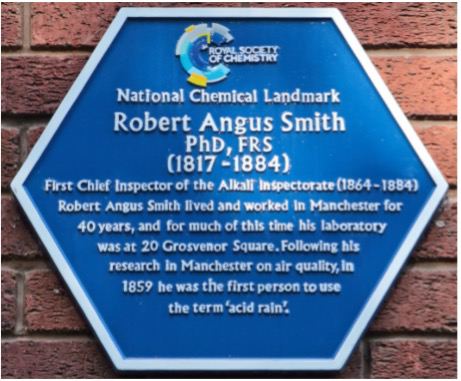 Meanwhile, the Scottish chemist, Robert Angus Smith, set out to investigate the chemical composition of the air and conducted a systematic survey of the British Isles. He described acid rain in 1852, a consequence of burning sulphur rich coal. He published his book, Air and Rain: The Beginnings of a Chemical Climatology, in 1872. As a consequence of his scientific integrity, he was appointed as the first head of the Alkaline Inspectorate, in 1874 and became a prototype of a scientific civil servant.
Meanwhile, the Scottish chemist, Robert Angus Smith, set out to investigate the chemical composition of the air and conducted a systematic survey of the British Isles. He described acid rain in 1852, a consequence of burning sulphur rich coal. He published his book, Air and Rain: The Beginnings of a Chemical Climatology, in 1872. As a consequence of his scientific integrity, he was appointed as the first head of the Alkaline Inspectorate, in 1874 and became a prototype of a scientific civil servant.
In 1882, fellow Scotsman and meteorologist, John Aitken set out to investigate soot particles in the air. He is the founder of cloud physics and aerosol science and is best known for analysing clouds and fog. Most importantly though he identified that air pollution did not stay in towns and cities but moved around on air currents.
The fact that air pollution does not respect borders was well known at the time. Even the public was aware of it and writers frequently wrote about it in their books. Dickens used it as a feature in the Sherlock Holmes books and smog events became a defining part of Victorian London. Henrik Ibsen’s play (Brand, 1865) also showcased the long-range transportation of pollutants: “Worse times, worse sins through the night of future flashes of Britain’s suffocating coal dust is slowly descending over the countryside, soiling all that is green ..”
”Even with plentiful evidence proving the harmful effects of smoking chimneys in industrial towns, coal was still an indicator of prosperity and wealth, rather than a public health concern.”
Public Health Act
The Industrial Revolution worsened things with factories emitting toxic fumes with new pollutants entering the atmosphere. Air pollution in Britain from the chemical industry triggered the passing of Alkali Act in 1863. It intended to reduce hydrogen chloride (HCl) emissions from the production of alkali by sending out agents of the Alkali Inspectorate, such as Robert Angus Smith, to question industry officials and recommend improvements. However, there were no actual regulations until the revised version in 1906.
In 1875 The Public Health Act (UK) gives the government responsibility to ensure public health. Thereupon, the government appoints a Royal Commission on Noxious Vapours to look into the growing problem of industrial air pollution. Their report brought better regulation but warned about impeding economic growth even though the damage was the result of uncontrolled industry. The UK government was reluctant to take remedial action because of the importance of industry to the national economy. Thus, there was no meaningful decrease in emissions. Worst of all, this piecemeal approach to use the ‘best practicable means’ just exacerbated the situation and meant no actual enforcement of legislation.
Meanwhile, Germ theory of diseases was finally accepted in the 1890s after the 1866 cholera outbreak in London. To compare, miasma theory only stated that bad air was the main cause of every disease, whilst germ theory states that diseases are spread and caused by micro-organisms within the body transferred through different mediums like water, food, or physical contact.
Another growing ambient problem of the late 19th century was the quantity of horse manure on urban roads. This led to the great manure crisis of 1894 in New York and London. Eventually this sped up the replacement of horse drawn transport to motorised vehicles in the early 20th century. Simultaneously, smoke accumulation in urban areas led to growing incidents of ‘killer’ urban fogs. These events prompted the 1905 London Public Health Congress, where Dr Henry Antione Des Voeux first coins the term ‘smog’ in his report.
Killer incidents and the manifestation of air-fouling
During smog periods the effects on human health were very evident particularly when smog persisted for several days. Many people suffered respiratory problems and increased deaths were recorded, notably those relating to bronchial conditions. At the time London was quite famous for its smog events. By the nineteenth century, many visited London just to see the capital in the fog. Smog includes both particulate and gaseous components, but the visibility is mostly affected by particulate matter (PM).
Early legislation of modern air pollution controls developed through the late 19th century mainly in Europe, North America but also in India and Hong Kong. The wide range of international laws was reviewed at the aforementioned Public Health Congress in 1905.
Unlike his Victorian predecessors, the Irish environmental engineer John Switzer Owens, transformed air pollution science from haphazard inquiries into a systematic national surveillance programme. He established the first national network of pollution monitoring between 1912 and 1936. His results showed that the policies to restrain industrial air pollution weren’t adequate. He also managed to prove that the atmospheric dirtying did not confine to cities but in fact can travel 1000s of kilometres.
“The early 20th century saw automobiles replacing horse carriages, causing a new source of air pollution to surface.”
By 1923, the US was producing 20 million cars per year. While in Europe, the first world war led to the rapid development of mass production techniques, and by 1932 the UK became Europe’s largest car producer. Little attention was drawn to the emerging of new atmospheric pollutants (HC, VOCs, PMs, CO, NOx) and their combined effect in the urban chemical climate.
In the following decades a series of tragedies made many communities face the adversities caused by air pollution. In 1930, in the narrow industrialised valley of Meuse in Belgium, a three-day weather inversion caused thousands of people to suffer breathing problems and 63 died of painful coughing and breathlessness which lead to heart failure. In 1948, a two-day smog event in Donora, US, resulted in 22 deaths and many reporting breathing difficulties. In the same year, 600 deaths were reported in a London killer incident. And in 1950, 22 died and 320 were hospitalised in Poza Rica, Mexico.
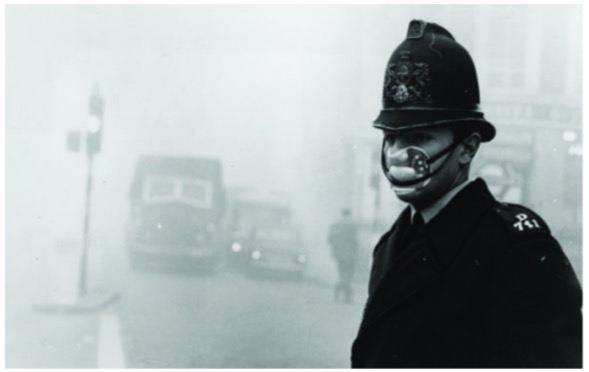 In December 1952, approximately 12,000 people suffered a premature death in the Great London Smog. Until the 1950s, air pollution was largely accepted as a consequence of industrial activity. It took a major event like this to change the public and political perception of the problem. 1956 brought another killer smog where 1000 died. The manifestation of these tragedies led to the passing of the Clean Air Act. To reduce ground level concentrations of SO2 and smoke, the new power stations were built with super high chimney stacks. Regardless of these efforts nations in the 1960s continued to experience further killer incidents. Even though in the following 3 decades, 1960s – 1980s, power stations went through improvements, emissions in the UK were still considerable and reached a peak in the 1960s.
In December 1952, approximately 12,000 people suffered a premature death in the Great London Smog. Until the 1950s, air pollution was largely accepted as a consequence of industrial activity. It took a major event like this to change the public and political perception of the problem. 1956 brought another killer smog where 1000 died. The manifestation of these tragedies led to the passing of the Clean Air Act. To reduce ground level concentrations of SO2 and smoke, the new power stations were built with super high chimney stacks. Regardless of these efforts nations in the 1960s continued to experience further killer incidents. Even though in the following 3 decades, 1960s – 1980s, power stations went through improvements, emissions in the UK were still considerable and reached a peak in the 1960s.
During the 1950s, 10 Downing Street went through a sizeable renovation. George Downing, an ex-diplomat and government administrator, secured leases to the property in 1682. He was a fortune seeker and, in order to maximise profit on the terraced houses, he used inferior foundations on the boggy ground. Instead of brick facades he used mortar lines drawn evenly. As Churchill wrote: ‘Shaky and lightly built by the profiteering contractor whose name they bear.' The facelift was initially estimated to last for 2 years with a budget of £500,000. It ended up taking a year longer and costing double the original price. The building was completely gutted, and it was this lengthy renovation where they discovered that the familiar exterior facade wasn’t black at all, but yellow. It had blackened in colour as a consequence of two centuries of severe pollution which had started with London's energy revolution in the 1600s.
Long term monitoring activities only started in the 1950s. The first network of air pollution measurement the so-called European Air Chemistry Network (EACN) launched in 1955. The need for tropospheric pollution observation steadily grew, promoting the development of passive remote sensing techniques. Starting in 1981, 1984, through 1994, and finally a more advanced satellite system was launched by NASA in 1999 (MOPITT).
“At the same time, besides killer smogs, environmental impacts from industrial and traffic emissions started to manifest as well.”
Events of acid rain, forest decline, eutrophication, and ground-level ozone arose. The latter posing serious risks by shortening lives especially in strong sunlight in basins where polluted air frequently becomes trapped (e.g., Po Valley, Italy; or LA, US). Ozone is produced through photochemical degradation of CO and VOCs in the presence of NO2. Acid rain was first described by the Victorian Robert Angus Smith, however, its effects were not considered catastrophic until it impacted Scandinavia in the 1960s where the soil types there are especially vulnerable. Many forests, rivers and lakes were rendered lifeless, pine trees died-back, freshwater acidified and fish populations were diminished, all caused by an annual dose of sulphur in rain events that quickly overwhelmed ecosystems.
These atrocious incidents coerced the 1972 Stockholm Conference, into what is considered a turning point in environmental science.
The slow introduction of legislation
Even though the Victorians had already reported the long-range transportation of pollutants, it wasn’t considered important until 1967. Only since the Air Quality Act of 1967 (US) was it recognised as an international issue. During the Conference, many recognised the inter-country effects of pollution due to atmospheric chemistry and physics affecting ecosystems. However, legal infrastructures, monitoring and analytic tools were still lacking, so the actions taken were yet again insufficient. Taller chimney stacks were built on power stations to disperse pollutants without considering the polluting effects caused outside their territories. Only in the late 70s were international frameworks set up to address the problem. Negotiations continued to focus on the reduction of sulphur emission in the mid-1980s, mostly by arbitrary agreements within European countries (Helsinki Protocol; The 30% club). However, regardless of these changes, Europe experienced a peak of emissions in the ‘80s.
“From the 1990s, human health effects from ground-level ozone and PM2.5 became the primary focus of air pollution control.”
By the ‘90s sulphur emissions had decreased, however, the outdoor concentrations of PM2.5 became a pressing issue as it’s the main long range transporter of sulphur and NOx and many links between air quality and climate change are due to the interactions between PM and the climate. Based on its contribution to the chemical climatology of the atmosphere, PM will continue to dominate control measures for decades to come.
As satellite measurements have revealed, emissions have declined in Europe and America between 1996 and 2004, as a result of the control efforts and since the ‘80s China and Asia have replaced Europe and North America as the main source of global emissions. More recent evidence has shown a reduction in China’s emission trends in both sulphur and NOx since 2012. Recovery seems to have started and the world may have passed the point of maximum emissions of several major air pollutants. However, emissions of ammonia, VOCs, ground-level ozone, CO2 and PM continue to rise with an adverse effect on climate change.
The 21st century
The global burden of air pollutants has continued to increase into the first two decades of the 21st century. In 2012, the WHO stated that 7 million premature deaths resulted from atmospheric pollution exposure. Dirty air is the world’s largest environmental health risk to human health. In addition, the majority of the world's population live in locations where ambient PM2.5 exceeds the WHO guideline values.
Wood burning became popular again in the 21st century with wood burning emissions first detected in Paris in 2005 and found in other major cities in Western Europe and Canada. In 2015, a UK government survey revealed that 1 in 12 UK homes burnt wood, which produces 2.6 times more particle emissions (PM) than traffic exhausts. This means that burning wood causes 6 times more cancers than pollution from diesel trucks. As wood smoke builds up in an area and drifts into people’s homes there is greater exposure to this pollution in residential areas than from busy roads at times of even modest wood burning activity.
“As a result, in a number of countries wood burning is already banned or at least regulated to avoid green wood burning.”
At the time of the pandemic one source of emissions, traffic, was drastically reduced resulting in a significant decline in NOx emissions. However, energy usage increased as people worked from home. This is why air pollution, climate change and public health need to be dealt with simultaneously as each effects the other.
Concluding remarks
By looking backwards to look forward, we allow ourselves to learn and make informed plans for future action. The air we breathe is the ultimate shared resource. It is not and cannot be owned. Air pollution problems can only be resolved through collective actions across society, which is why government policies are crucial. Despite the overwhelming economic benefits of acting to reduce air pollution, policies and strategies are constrained by what is thought to be politically acceptable. Managing air requires a holistic approach and reducing the health burden from air pollution surely is a substantial prize for society as a whole.
Latest Articles
The business risks emerging from the global COVID-19 pandemic
Read More >Why indoor spaces have a higher risk of virus transmission
Read More >Enhance HVAC performance, improve energy efficiency and reduce emissions
Read More >High absenteeism and reduced wellbeing
Read More >How does air quality affect your business
Read More >What the experts say
Read More >Risk indicators and monitoring
Read More >Ventilation and filtration
Read More >Transmission & Prevention
Read More >Ambient Air Pollution
Read More >Indoor air pollution & the indoor generation
Read More >Climate change and the climate emergency
Read More >What’s in the air we breathe outdoors?
Read More >What’s in the air we breathe indoors?
Read More >Other indoor biological pollutants
Read More >How air pollution affects our lives
Read More >















